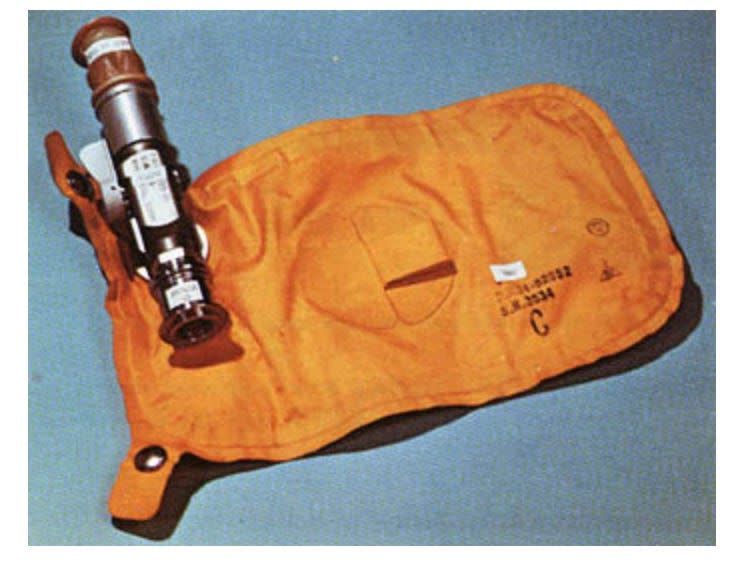It's Hard to Poop on the Moon. NASA Wants You to Make It Easier.
NASA has partnered with the crowdsourcing platform HeroX in its search for the next lunar toilet.
Do your, uh, duty and design the next toilet that astronauts will use on the moon.
The prize for designing the perfect space crapper? $20,000.
In the next few years, NASA plans to return to the moon. We know which rocket the astronauts will launch atop, what capsule they'll be cramped in, and how they might land on the lunar surface.
But there's one critical mystery NASA still has yet to solve: How will they poop?
Enter the Lunar Loo Challenge. NASA's Tournament Labs and Human Landing System Program has partnered with a Kickstarter-like platform called HeroX to sponsor a competition to design a space toilet that will be used on the moon.
"These astronauts will be eating and drinking, and subsequently urinating and defecating in microgravity and lunar gravity," according to an overview of the challenge. "While astronauts are in the cabin and out of their spacesuits, they will need a toilet that has all the same capabilities as ones here on Earth."
Clearly, dropping a deuce in space is no small feat.

Apollo-era astronauts famously hated their toilet system. The Apollo Fecal Containment Device was essentially just a plastic bag that the crew strapped to their butts. Once they deposited their waste, the bags were either stored on the spacecraft or left on the lunar surface.
On one mission, the poop escaped. During the 1969 Apollo 10 mission, commander Tom Stafford had to quickly take care of a stinky situation. “Give me a napkin quick,” he said. “There’s a turd floating through the air.”
During the first Space Shuttle mission in 1981, astronauts had to unclog the smelly toilets, making for a messy scene. Frozen urine flushed from the Russian Mir space station damaged the station's solar panels over time, reducing their effectiveness by around 40 percent.
Fortunately, over the years, NASA and other space agencies have gotten a better handle on the business of going #1 and #2. On the International Space Station (ISS), urine is sent through a network of hoses and is eventually recycled into drinking water. Feces collected aboard the ISS are sucked into a canister, which is then shot back toward Earth. (Don't worry, it burns up in the atmosphere.)
But now it's time for a new generation of space toilets. NASA is already working on a brand new toilet design for the ISS, called the "Universal Waster Management System," and the agency needs your help to design the next lunar toilet. There are several design and performance specifications that must be met before NASA can let the new loo loose on the moon:
💩It has to be able to accommodate the waste of two astronauts for at least 14 days.
💩It has to work in both microgravity and lunar gravity.
💩It can't use more than 70 Watts of power.
💩It can't be smelly.
💩It has to hold all sorts of waste including urine, feces, vomit, diarrhea, and menstrual blood. "[B]onus points will be awarded to designs that can capture vomit without requiring the crew member to put his/her head in the toilet."
💩It has to accommodate both men and women.
💩It has to flush properly.
💩It has to be quick and easy to clean. You don't want to be spending time hovering over the toilet with a scrub brush when you could be, I don't know, exploring the moon.
💩It has to be able to flush 500 grams (about 2 cups) of diarrhea in one sitting.
💩It has to be quiet. (No louder than 60 decibels, please.)
NASA says it's already working on ways to adapt current designs, so submissions must be different from, say, what's currently on the ISS. In order to be seriously considered, the design has to be simple and efficient.
This isn't the first time NASA has crowdsourced this particular pressing problem. In 2017, the agency launched its Space Poop Challenge, which requested help on designed toilets to be used while astronauts are strapped to their seats. (Here are the winners.)
The Lunar Loo Challenge is split into two categories: technical, which is open to adults, and junior. "We want to encourage the next generation of space explorers, engineers, and scientists, and we know that students may think about this design problem without the same constraints as adults," the website says of the junior category, which will accept submissions from students 18 and younger.
A $35,000 grand prize for the technical category will be split among the top three designs, with $20,ooo going to the first place winner, $10,000 to the second place design, and $5,000 to third place. Winners will also receive a behind-the-scenes tour of NASA's Johnson Space Center and will have the opportunity to meet with NASA engineers and, possibly, an astronaut. The top three winners of the junior competition won't be eligible for the cash prize, but will instead walk away with some street cred and a NASA T-shirt.
The deadline to submit your materials—a PDF explaining how the toilet works and a neutral 3D CAD file—is August 17, 2020, at 5 p.m. EDT. Judging will close on Sept. 22, 2020, and the adult winners will be announced on Sept. 30 at 2 p.m. EDT. Junior winners will be announced on Oct. 20.
Now that you have your marching orders, get started! Don't let a minute go to ... waste.
You Might Also Like

